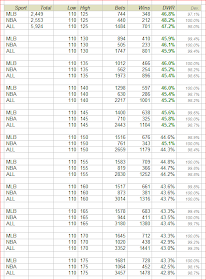Once again, odds were just too funky today to enable me to make seven "dog" selections that were not too risky, but Tuesday looks promising and should put us back on track.
In the meantime, as we count down the days until the Boys of Summer stop messing about and get serious, I'd like to take a closer look at the spread range topic I have touched on a few times recently.
I am not talking about spread as in the difference between the winning and losing score, or spread as a target betting ingredient, but the odds range within which underdogs "qualify" for our consideration.
As readers who have been with me for a while will know, I opened the 7-dog trial last November 1 with a qualifying range from +100 (even money) to +180 (a payback of $1.80 on the dollar).
As the months have rolled by, I have tightened my net somewhat, occasionally making bets at less than even money to back spreads or totals - lowering the floor - and dropping my ceiling to +130 or less most of the time.
That was a mistake.
I know that not just from the 7-dog trial's current struggles, but from running tests using all the baseball, basketball, football and hockey games I have in my ever-growing database.
When it comes to betting the underdog as a matter of course, the math is as math tends to be: pretty simple.
Our goal is to hone our selection process so that we can achieve a long-term dog win rate (DWR) of 45% or better along with a rate of payback that does more than simply offset the damage done by a negative expectation of (-)10.0%.
To break even with a 45% DWR, we need an average payback of 55/45 or +123 in bookie-speak.
We are not in the game to break even, naturally, but target betting will take care of providing a profit so long as we do our part and make underdog selections that are not dachshunds (long dogs!).
It makes sense, therefore, to be as picky as we can without being so selective that we can only place a bet once in a blue moon.
I have said before that on the basis of careful study of past outcomes, I favor a minimum of +110 and a max of +145.
Here's why:

Dognostics will spout their usual guff about past results being anecdotal and irrelevant and blah, blah, blah, and the database reflects how wrong they are.
It is absolutely (and obviously) true that future outcomes can never precisely mirror what has gone before.
So absent crystal balls, we have to use archival data to be as sure as we can be that trends that seem favorable are not just meaningless anomalies.
The ALL in the table above refers to almost 6,000 games dating back to the beginning of 2008.
The biggest slices of the pie come from major league baseball (MLB) and hockey (NHL) and in order to be sure that one of those sports did not deliver patterns that wildly differed from the other, I tracked them separately as well as collectively.
The column on the far left looks at the DWRs reported on each line and indicates deviations between the maximum win percentage achieved and those for MLB and NHL.
As you can see, the 45% DWR optimum is met from a very narrow range (+110 to +125) all the way up in steps to +110 to +145, and after that, the drop-off gathers speed until I stopped the analysis at +110 to +175.
Let's be clear: target betting will deliver profits from a DWR below 45%, but we want to maximize returns while minimizing risk, unlike most of the gamblers who keep casinos and bookies in business.
Happy as I once was with paybacks as low as even money (+100) I now see the error of my ways and will bet smarter in future.
I did however extend the test to +105 and up, with the following results:

Again, consistent results from component data sets that comprised the ALL.
All of these numbers are entirely consistent with commonsense expectation.
The longer the odds, the fewer the wins. Surprise!
But it all comes down to the fact that underdogs must win consistently (but not constantly!) in order for the bookies to pay for their luxury lifestyle.
More about this later.
And tomorrow, hopefully, back to the 7-dog trial!
An important reminder: The only person likely to make money out of this blog is you, Dear Reader. There's nothing to buy, ever, and your soul is safe (from me, at least). Test my ideas and use them or don't. It's up to you.
_
No comments:
Post a Comment
I am happy to hear constructive criticism from people genuinely interested in improving their game, but life is too short for the drivel that too many posters have made their stock in trade. If insults are your game, not blackjack, please go away. If you work for a casino, you will know that progressive betting is only for fools, a surefire way of losing your bankroll. If you take blackjack seriously, as a player, you will know that that is a lie, one that the gambling industry promotes to protect its bottom line. I hope you will find something here of value. Thanks.